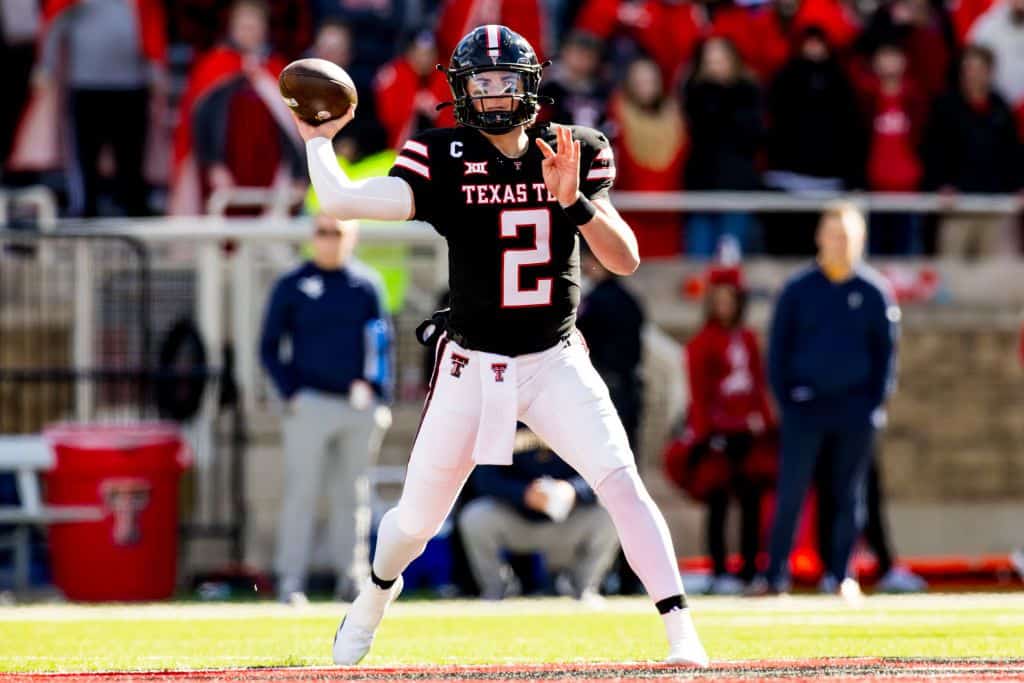This season, I’m breaking down a few of college football's biggest games each week and giving out at least one bet I like from each matchup.
Let’s take a closer look at a top-10 showdown in the Big 12 between Texas Tech and BYU.
BYU vs. Texas Tech, current line:
BYU at Texas Tech Best Bet Prediction:
There is a substantial talent gap in this contest, especially when BYU is on offense, so let’s lay the points and take Texas Tech against the spread.
- BYU vs. Texas Tech, best line: Texas Tech -10
» Bet it now at Novig: Texas Tech -10.5 points
When BYU is on Offense
BYU utilizes a slow, run-heavy approach under coordinator Aaron Roderick, leaning on both running back LJ Martin and freshman quarterback Bear Bachmeier.
According to Campus2Canton, the Cougars run the ball at a rate 4.8% above expected based on situational data, the second-highest rate in the Big 12.
BYU also ranks 112th in the nation in pace of play, using the run game to bleed the clock and shorten games.
This strategy typically works well for BYU and allows it to compete with more talented rosters, like Texas Tech.
However, the Red Raiders' defense is built to contain the run game, and this looks like a tough matchup on the ground for the Cougars.
Take a look at these opponent-adjusted numbers from Sports Info Solutions:
- BYU: ranked 85th in yards before contact
- Texas Tech: ranked 14th in yards before contact allowed
- BYU: ranked 20th in yards after contact
- Texas Tech: ranked 4th in yards after contact allowed
BYU tends to rely on heavier formations, which allows defenses to stack the box and further complicates things for the Cougars in this matchup.
Texas Tech defensive coordinator Shiel Wood is one of the few who still prefers to line up with a stacked box, and does so at a rate 38% above expected based on opponent-adjusted data.
And Wood has good reason to lean heavily on those formations this year, as his Red Raiders have been dominant with seven or more defenders in the box:
- 0.2 yards before contact per attempt, ranked 1st
- 1.9 yards per attempt, ranked 3rd
- 28% of carries stopped for zero or negative yards, ranked 11th
Martin has been strong in BYU’s heavy formations, averaging 6.1 yards per attempt, so perhaps he can find some success against Texas Tech.
However, Martin does not fight through early contact as easily as you might expect given his 220-pound frame.
When hit at or behind the line of scrimmage, Martin is averaging just 1.6 yards per attempt (ranked 31st out of 59 qualified power conference running backs).
That is also a red flag for BYU against the Texas Tech run defense that creates early contact 46% of the time and converts that early contact into a stop at or behind the line of scrimmage 48% of the time, the nation’s 21st-highest rate per Sports Info Solutions.
All of those numbers only reflect the run game on handoffs, however, and Bachmeier is also a critical piece of BYU’s attack.
Against FBS competition, Bachmeier is averaging 11.2 carries per game, excluding sacks, for 60.0 yards.
Bachmeier’s mobility undoubtedly adds value to the Cougar offense, though he’s more efficient than explosive.
Based on opponent-adjusted data, Bachmeier’s rushing numbers (on a per-attempt basis) are 8.1% below expected, ranked 50th out of 74 qualified quarterbacks.
So expect Bachmeier to keep some drives alive with his scrambling ability, but don’t count on him carrying the workload with his legs if Martin’s contributions are shut down.
In the passing game, BYU should be able to negate Texas Tech’s pass rush, which has been the team’s greatest strength on defense.
Check out these opponent-adjusted numbers on the pass protection battle from Sports Info Solutions:
- BYU: ranked 36th in pressure rate allowed
- Texas Tech: ranked 24th in pressure rate allowed
Although Texas Tech appears to have a slight edge, BYU’s success is more sustainable due to the nature of its scheme.
Bachmeier only takes a traditional dropback 38% of the time (average is 50%) and tends to get the ball out quickly.
In an effort to speed up the passing game and put less pressure on the offensive line, BYU uses quick dropbacks (one-step dropbacks and RPOs) 32% of the time, per Sports Info Solutions.
Leaning even more on the quick passing game could be a good strategy against Texas Tech to limit the Red Raider pass rush.
However, Texas Tech has still defended the quick passing game well.
Against quick dropbacks, Tech is allowing just 4.4 yards per attempt, the nation’s seventh-lowest rate.
Since most quick dropbacks are designed to attack underneath, Tech’s ability to limit yards after catch explains the production.
The Red Raiders rank 34th in yards after catch per reception allowed overall and 18th on throws five or fewer yards downfield, with much credit going to their excellent safety duo of Brenden Jordan and Cole Wisniewski.
Due to its ability to defend the run and shorter throws in the passing game, Tech excels at forcing opponents into tough down-and-distance situations
Texas Tech opponents face third and long 32% of the time, the nation’s fourth-highest rate.
That’s concerning for BYU’s offense, which only ranks 47th by the same metric.
And this is where Texas Tech’s advantage becomes clearer.
In those third-and-long situations, Bachmeier will need to take more traditional dropbacks in an effort to attack downfield.
So let’s look at pressure rate on traditional dropbacks, via Sports Info Solutions:
- BYU’s offense: 43%, ranked 79th
- Texas Tech’s defense: 55%, ranked 2nd
So BYU absolutely must find success on early downs to avoid putting its freshman quarterback in that situation against one of the nation’s most dangerous pass-rush units.
When Texas Tech is on Offense
Texas Tech runs a pass-heavy offense under coordinator Mack Leftwich, who is in his first year calling plays for the Red Raiders after previously filling that role at Texas State.
According to Campus2Canton, Tech throws the ball at a rate 5.2% above expected based on situation data.
This pass-heavy approach has the potential to be a problem for BYU’s defense, which hasn’t been tested by many competent passers this season.
Utah’s Devon Dampier is a quality quarterback, but mostly for running ability 一 he’s a liability as a downfield passer.
So the best passer BYU has faced was Iowa State’s Rocco Becht, who threw for 311 yards and helped the Cyclones average 7.1 yards per play.
BYU ultimately won that game by two scores thanks to Iowa State’s injury-ravaged secondary and 3 interceptions by Becht.
Obviously, BYU gets some credit for forcing those interceptions, but we shouldn’t bet on a similar performance against the Red Raiders.
Although BYU ranks among the nation’s leaders in interceptions, its defense only ranks 59th in ball-hawk rate, making a play on the ball 12.4% of the time, per Sports Info Solutions.
In partial-season sample sizes, interception rate can fluctuate drastically, but ball-hawk rate is a good predictor of future success in that area.
So while that 3-interception performance was clutch and impressive, it’s not predictive at all.
To slow down Texas Tech’s passing attack, BYU will need to rely on its pass-rush unit, which has been the strength of the defense.
Take a look at the pass-protection battle based on these opponent-adjusted numbers from Sports Info Solutions:
- Texas Tech: ranked 9th in pressure rate allowed
- BYU: ranked 14th in pressure rate generated
If Tech can protect Behren Morton, expect the Red Raiders to have success throwing downfield.
Tech only throws downfield at a league average rate 一 outside the red zone, 23% of its attempts have been 15 or more yards 一 but Morton has been excellent at that depth.
On throws of 15 or more yards, Morton is completing 48% of his attempts (ranked 28th) with a 58% on-target rate (ranked 25th), per Sports Info Solutions.
BYU ranks 75th in completion rate allowed at that depth outside the red zone.
Although the run game is not the focal point of the Red Raider offense, expect lead rusher Cameron Dickey to have room to make some plays on the ground.
Check out the run game matchup via these opponent-adjusted stats from Sports Info Solutions:
- Texas Tech: ranked 30th in yards before contact
- BYU: ranked 111th in yards before contact allowed
- Texas Tech: ranked 76th in yards after contact
- BYU: ranked 48th in yards after contact allowed
Another key factor in this game could be the Red Raiders' tendency to lean heavily on RPOs.
Tech has used RPOs on 31% of its dropbacks, the nation’s 13th-highest rate.
This style of play could be problematic for a BYU defense that is allowing 5.5 yards per play against RPOs (ranked 66th), per Sports Info Solutions.
This was a problem for the Cougs last week against Iowa State, as the Cyclones ran 10 RPOs for 120 yards.
Due to BYU’s overall mediocrity on defense, but especially due to its inconsistency against the run, the Cougars have only forced opponents into third-and-long situations 22% of the time (ranked 80th).
It’s hard to beat good teams if you can’t consistently get them off the field, so this could be the week BYU’s defense gets exposed.
Final Thoughts on BYU vs. Texas Tech Best Bets
This is likely the week that BYU’s luck runs out 一 take Texas Tech against the spread.
Since this is a large spread, don’t go crazy, but it’s hard to imagine BYU staying competitive in this matchup.
BYU’s offense hasn’t faced a complete team like Texas Tech all year, and this is likely to be the game that exposes the Cougars' flaws on a big stage.



















